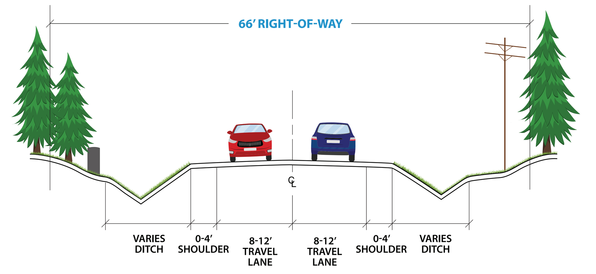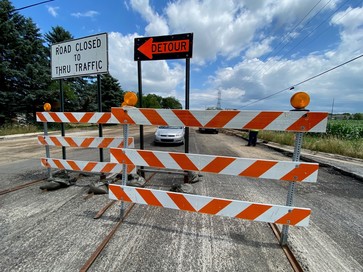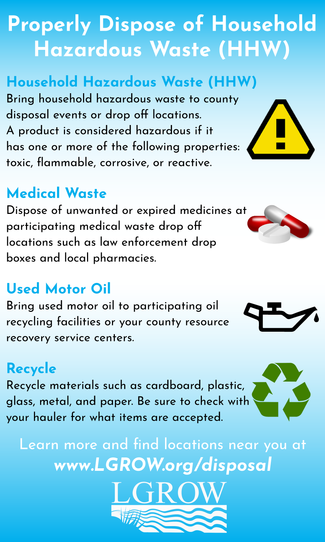 All county roads are located on land that is referred to as the road right of way.
This road right of way is intended to support county road, pedestrian facility, and public utility purposes.
The right of way concept was created to provide adequate space on either side of the road for storm drainage and a safe recovery area for vehicles that leave the road surface.
Although distances can vary, the general rule of thumb is that the right of way is 66 feet wide — 33 feet on both sides of the road’s centerline. It’s advisable that an engineering or surveying firm be used to determine the actual width and location of the right of way, as widths and locations can vary.
The Road Commission is charged with ensuring that all roadways within its jurisdiction are reasonably safe for public travel. This includes enforcement of the improper placement of hazardous encroachments in the right of way which present a potential safety hazard to the traveling public.
In order to help the Road Commission achieve this goal, Michigan PA 283 of 1909 requires a permit from the Road Commission to construct, operate, maintain, or remove any facility or perform any work within the road right of way.
You may visit our Special Services Department website to learn more about the various permits, and rules and regulations for working within the road right of way.
And to learn more about the road right of way, download and read our Understanding Road Right of Way handout, located on our website.
While it might seem like we're banging a familiar drum, we once again need to remind people that you shouldn't drive in a road closure zone.
When a road is closed, the condition of the road is far different from when it would be open to traffic.
The lack of pavement, presence of heavy construction machinery and materials, and possible hazards such as trenches, large holes and precarious objects sticking up from the ground are just some of the obstacles you'd find in a road closure area.
These obstacles are an obvious hazard, and can damage your vehicle, and even cause severe injury or worse.

In addition to being important for your safety, it is also important for the safety of the men and women working in a construction zone.
Excess traffic -- meaning anything beyond the vehicles involved in the construction project and those reisdents/citizens who live/work within the closure limits -- can increase hazards for workers on the job site.
Please be reminded that if you do live or work within a road closure zone and must drive into a road closure, be mindful of construction crews and heavy equipment, and know that you'll be unable to drive on the road like you would if it were open to traffic.
Slow down, drive with caution, and be on the lookout for workers, materials and equipment, and give yourself extra time to get from one place to another. Be sure to follow all instructions given by people on the scene directing traffic.
We appreciate -- and our crews out in the field especially value -- your understanding and following through with this request.
|

The Ottawa County Road Commission works with other local organizations to safeguard health and the environment.
As you’re cleaning up your home and yard, take special care to dispose of household hazardous wastes appropriately so that you protect people’s health and the environment.
Products such as paints, cleaners, oils, batteries, and pesticides can contain hazardous ingredients and require special care when you dispose of them.
What is a household hazardous waste? A product is considered hazardous if it has one or more of the following properties:
- Toxic – poisonous or lethal when ingested, touched or inhaled;
- Flammable – ignitable and burns easily;
- Corrosive – eats through materials and living tissue; or
- Reactive – can possibly explode or react with other chemicals.
Improper disposal of household hazardous wastes can include pouring them down the drain, on the ground, into storm sewers and roadside ditches, or in some cases putting them out with the regular trash, which can spill into the road right of way.
The dangers of such disposal methods might not be immediately obvious, but improper disposal of these wastes can pollute the environment and pose a threat to human health. Certain types of household hazardous waste have the potential to cause physical injury to sanitation workers or to contaminate septic tanks or wastewater treatment systems if poured down drains or toilets.
They can also present hazards to children and pets if left around the house. Storm sewers and road ditches lead directly to surface waters without being treated, so dumping waste in storm drains and road ditches pollutes nearby creeks, rivers and lakes.
Make sure any household hazardous wastes are safely disposed of according to your community’s guidelines.
To find out how and where to dispose of household hazardous waste, visit https://www.miottawa.org/Health/OCHD/eco.htm#hazardous. You can also swap out chemicals when possible for all-natural cleaning supplies. To find products that are safer for people and the environment, check out http://www.epa.gov/saferchoice.
By safely disposing of household hazardous waste, you are doing your part to “Keep your Lakes Great and your River Grand”!
|

A reminder that the Ottawa County Road Commission's latest Road Commission transportation plan -- the Draft 2021-2025 Strategic Improvement Plan (SIP) -- is still available for review and public comment.
This plan is based on an annual review of the county road assets in order to identify improvement needs, and determine economical methods to finance improvement and maintenance projects.
Before the Draft 2021-2025 SIP is finalized, it is vital to the process to gather input and comments about the proposed projects within this draft plan from our local governmental partners and the general public. Please submit your comments by September 1, 2020. Your comments are strongly encouraged and are greatly appreciated.
If you have any questions or require additional information, contact our office at 616–842–5400 or email info@ottawacorc.com.
|
|






